SUN AN’ SOUL - DREAM AN’ ROME
BARBERINI PALACE AND GALLERY
 |
| Barberini Palace and Gallery - click to enlarge |
The Barberini were a family probably original from Barberino Val d'Elsa in the province of Florence, where they moved in the thirteenth century. Under Pope Paul III Farnese, around 1540 they left Florence for Rome. Welcomed in the papal court. "With Florentine sparingly", their contemporaries said, amassed huge fortunes until rising to the papacy with Maffeo Barberini who in 1623 took the name of Urban VIII.
A papal family need a worthy building, so it was that in 1625 the greatest architect of the time Carlo Maderno (1556-1629), who had just finished the construction of St. Peter in the Vatican, was commissioned to design Barberini palace.
Old and nearly blind Maderno totally entrusted Francesco Borromini (1599 - 1667), his grandson, the work, until in 1629 came to death.
Meanwhile the Florentine Pietro Bernini, known in Rome for the Barcaccia fountain in Piazza di Spagna, introduced, and well it seems, his son Gian Lorenzo at Urban VIII. Therefore Borromini found himself appointed first aid of Bernini (1598-1680). Bernini little knew about architecture and construction. No matter there was the good Francesco Borromini, whose original drawings, gathered in Vienna, show that Bernini took care only of the ornamental part of the interior, the design of the hall on the main floor and the monumental staircase.
But given the size of the building a staircase was not enough, then Borromini built another one, the unmatched helical staircase, compared which Bernini's work disappeared.
To retrieve the unexpected blow Bernini resorted to his best resources (art and flattery) and sculpted not one, but two busts of Urban VIII, one of whom truly amazing moreover he added the portrait of Cardinal Antonio Barberini the Elder,
brother of the Pope.
In the façade of the Palace Borromini's hand it is clearly visible in the three-dimensionality of the windows, probably encouraged by the same Maderno who appreciated the originality and imagination of his nephew.
Starting from 1633, once the Palace was completed, Pietro da Cortona painted one of his most complex works, the large fresco (24 meters by 14), “Triumph of Divine Providence”, he worked at the fresco for over six years, ending it in 1639. In this painting Pietro weaves a narrative, full of symbols and allegories, derived from the complicated text by Francesco Bracciolini, former secretary of Maffeo Barberini, as well as literary man. The problem that Peter solved is to maintain the unity of the composition, struggling with a variety of themes and sub themes. The end result is an extraordinary spectacle.
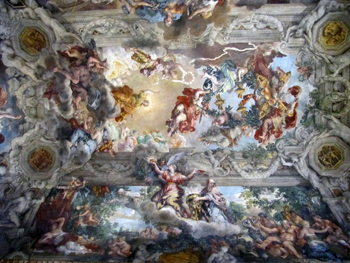 |
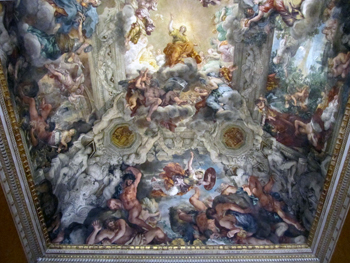 |
| Triumph of Divine Providence - click to enlarge |
The official name of the Barberini Palace Gallery is the National Gallery of Ancient Art, an expression that may be equivocal, fact in Rome sayng ancient one thinks to the ancient Romans.
The gallery, divided into 34 rooms, is exterminated. This overabundance of works, however, of greatest or almost great artists, inevitably causes in the visitor a sense of saturation.
This is a problem common to many Roman Museums, which could be remedied by drastically limiting the number of works exhibited, presenting permanently, by an appropriate set-up, only those which for overall judgment are considered unmatched masterpieces, while the spaces thus obtained could be used for thematic exhibitions, eventually showing part of the paintings set aside.
In accordance with this opinion, we will show you a some selected masterpieces, ignoring great authors such as Titian, Andrea del Sarto, Dosso Dossi, Garofalo, Lanfranco, Guercino and many, many others.
Let begin our journey with the beloved Fornarina (=baker girl).
So much beloved by Raphael (1483 - 1520), that Vasari wrote Raphael’s death was caused by "excessive love".
But who was the
Fornarina?
Her name was Margherita Luti, a baker's daughter (hence Fornarina). This identification seems to be confirmed by a document discovered in the late nineteenth century which states "today August 18, 1520, was received in our conservatory (the monastery of St. Apollonia) Madama Margarita daughter of Francis Luti."
In simple terms it means that Fornarina shortly after the death of his Raphael retired to a monastery.
 |
| Fornarina - click to enlarge |
After paying homage to the Fornarina, we resume our journey in chronological terms to meet the Madonna of Tarquinia by Filippo Lippi.
Frà (=friar) Filippo di Tommaso Lippi (Florence 1406 - Spoleto 1469), among the painters was one of the greatest, but between the friars was one of the most mischievous. Vasari writes: “It is said that he was so venereus (= lover of Venus), that when he liked a woman, he would have donated all his possessions to get her favours. And he was so lost behind this appetite, that when he was in this mood forgot any work”.
Our Gallery shows the famous Madonna of Tarquinia.
 |
| Madonna of Tarquinia - click to enlarge |
Piero di Cosimo (Florence from 1461 to 1521) was a pupil of Cosimo Rosselli, therefore was named Cosimo himself.
Young age in the wake of Rosselli was in Rome in 1481 where he worked with the master in achieving the frescoes of the Sistine Chapel “Crossing the Red Sea” and “the Sermon on the Mount”. Here he had the opportunity to meet Botticelli, Ghirlandaio, Luca Signorelli, they also working in the Sistine Chapel.
Piero has a reputation for outlandish man, misanthrope and full of phobias. Vasari wrote: “he was terrified by the thunder, he feared the fire, for convenience ate mostly eggs used to prepare the color, forbade to clean his shop and finally, in his later years, he lived more like a beast than a man”.
But Vasari is not always totally believable.
What we can say today is that, back in Florence, when died his master, he lived alone, fervently believed the preaching of Savonarola and after the putting to death of the monk withdrew even further into himself.
In the Gallery we can enjoy an unforgettable masterpiece: the Maria Maddalena.
 |
| Maria Maddalena - click to enlarge |
Quentin Metsys (Louvain 1465 - Antwerp 1530) was a pupil of the famous Flemish master Memling, he made his fair study tour in Italy and moved to Antwerp, where twenty-five years old, under the influence of Van Eyck, another Flemish painter, founded the school of Antwerp.
The works of Metsys note the moral tension that from Erasmus of Rotterdam was to lead to Martin Luther, this inspiration drove the artist towards a painting in which he combines realism and grotesque.
The Barberini Gallery exhibits one of his most famous works: “Erasmus of Rotterdam”, the portrait was to be a gift for Thomas Moore, close friend of Erasmus.
The portrait, typically Flemish for the atmosphere, colors and attention to every detail, dates back to 1517, that year was the split between Martin Luther and Pope Leo X, the excommunication will arrive in 1521.
 |
| Erasmo da Rotterdam - click to enlarge |
The Sienese Baldassare Peruzzi (1481 - 1536), was called to Rome by his fellow countryman, the great patron Agostino Chigi “the Magnificent”.
A central figure of the Renaissance, architect, set designer, military engineer, as painter excelled in Villa Chigi, known today as Villa Farnesina, in Sant'Onofrio, in San Pietro in Montorio, and in the Palace of the Chancellery. Baldassarre was one of many artists attracted by the irresistible and joyful personality of Raphael, with whom he collaborated on several occasions, particularly in the Stanze of Julius II, at Villa Madama and St. Peter in the Vatican.
During the sack of Rome in 1527, he was captured and mistreated by a band of landsknechts (=German mercenaries). For his release was paid a ransom. Then he fled from Rome to Siena.
Shortly after, in 1530, he returned to Rome where he died in 1536, according to Vasari poor, but this seems to be a poetic license, given that, as proof of his great fame, he was buried in the Pantheon next to his friend Raphael.
In the gallery we see his original Ceres.
 |
| Ceres - click to enlarge |
Lorenzo Lotto (Venice 1480 - Loreto 1556), didn’t learn the compromise style and was destined for unhappiness and oblivion.
He was rediscovered in 1895 thanks to the great art historian Bernard Berenson, who wrote: “To understand the sixteenth century, Lotto is as important as Titian”.
His troubled life took place in a constant back and forth between Venice, Treviso, Recanati, Rome, Jesi, Bergamo, Macerata, Cingoli, Ancona, Loreto, sometimes at risk of being accused of heresy or Lutheranism, and then to be subjected to Inquisition.
Lotto was one of the greatest portrait painters of the sixteenth century, the peculiarity that makes him unique is to be found in his desire to reveal the soul and talk to the person portrayed.
He knew the painting of all the great contemporaries: Giovanni Bellini, Giorgione, Dürer, Raphael, Leonardo, Correggio, Titian, but his style is unique and inimitable.
Our Gallery exhibits the “Mystic Marriage of Saint Catherine”, work of 1524, which expresses the uncorrupted religion of Lorenzo Lotto, as you can appreciate the simplicity with which depicts the Madonna and in general in the vividness of the composition (note the lion that accompanies St. Jerome).
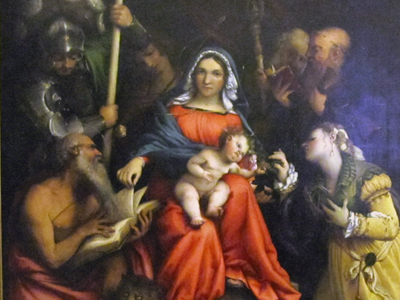 |
| Mystic Marriage of Saint Catherine - click to enlarge |
Domenico Beccafumi (Montaperti 1486 - Siena 1551), was the son of the farmer Giacomo di Pace, but since the noble Lorenzo Beccafumi provided him study painting, he took the last name of his patron.
In Florence, where lived his protector he met Frà (=friar), Bartolomeo and Piero di Cosimo and his early works one can read above all the influence of Piero.
In 1510 he was in Rome where he stayed at least two years and was thus able to know the painting both of Michelangelo, who at that time frescoed the Sistine Chapel, and Raphael engaged in painting the Stanza of the Segnatura in the Vatican.
Returning to Siena here he put his studio.
His “way” was matched with those of Frà Bartolomeo, Filippino Lippi, Sodoma, Pontormo, Raphael and others, it will be true, but the originality and greatness of Domenico Beccafumi is in his tension in wanting to go beyond the classic form of the Renaissance, which had reached such a level to be called exhausted.
Beccafumi entrusts this tension to a new language in which light and color abandon reality to land into the world of fantasy and imagination.
At the Gallery of Barberini Palace is exposed the delicate Madonna and Child with Saint John; in this masterpiece, that belongs to his maturity, is evident that he transcends the Renaissance balance, form - color, to create, through light and color, an imaginary world of new emotions.
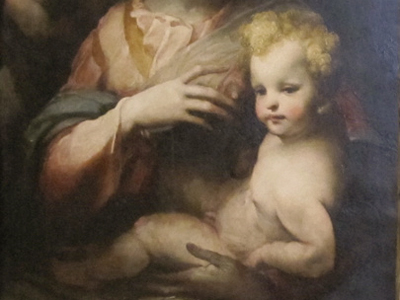 |
| Madonna and Child with Saint John - click to enlarge |
About Brescianino we know very little, uncertain is the date of birth (1486?) and that of death (1527?). The name by which he is known is due to the birthplace of his father, a professional dancer. His works seem influenced by Raphael, Andrea del Sarto and Beccafumi.
The gallery shows us his memorable portrait of Sulpizia Petrucci, wife of Sigismondo Chigi, brother of Agostino “the Magnificent"”.
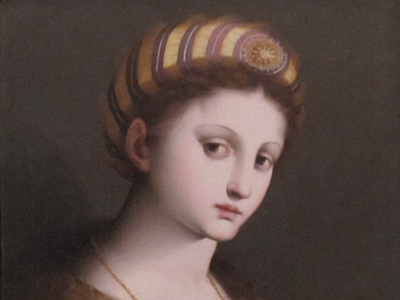 |
| Portrait of Sulpizia Petrucci - click to enlarge |
Giulio Pippi (Rome 1495/99 ? - Mantua 1546), better known as Giulio Romano, painter and architect, was the closest collaborator of Raphael, at his untimely death (1520), inherited the shop. He spent the years immediately after to complete in the “Stanze Vaticane” the Constantine hall, that Raphael had left unfinished.
Officially his birth is dated 1499, but Vasari, who knew personally Giulio, says that he was born in 1495. Considering that in 1520 he inherited the workshop of Raphael the Vasari version appears the most credible,
As architect his most famous work is the Te Palace, which was built for Federico II Gonzaga in Mantua.
He became so rich and famous that in 1546 was appointed first architect of the building of St Peter in Vatican, but while he was starting to Rome the death surprised him.
It was then that the seventy Michelangelo, who for thirty years and more consumed himself in the wait, became First Architect.
His experience as a painter can be divided between the time during which he collaborated with Raphael and the time following the death of his master.
The analysis of the first period is difficult because the work in the studio of Raphael followed a system that doesn’t allow easily to go back to single individuals, so it’s hard to recognize the hand of Giulio. In the next period Giulio followed his own independent path, which is characterized by a marked design, which does not permit large prominence to colors.
In the Barberini Gallery shines the Madonna and Child, one of his best works painted around 1523 shortly after Raphael's death, yet already an expression of Giulio self-style.
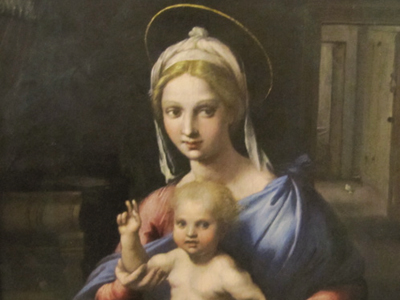 |
| Madonna and Child - click to enlarge |
Hans Holbein the Younger (Augsburg 1497 - London 1543), learned to paint in his father's shop (the Old). In 1515 the family moved to Basel where he met Erasmus of Rotterdam, and until 1526 he painted portraits for the wealthy merchants of the place, and even some religious subject.
Thanks to Erasmus and Thomas More letters of introduction escaped from Basel and the Lutherans and settled in London.
Finally in 1536 he was appointed personal painter of Henry VIII and became, let's say the official photographer of the English court.
The Gallery exhibits the famous portrait of Henry VIII in all his arrogant majesty.
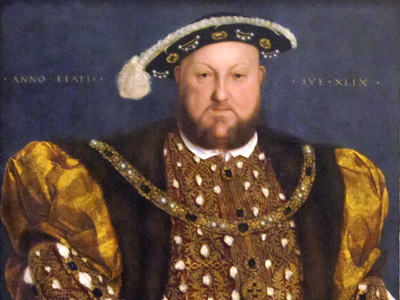 |
| Portrait of Henry VIII - click to enlarge |
Bartolomeo Veneto (1502 – 1555), where he was born we aren’t sure, but since it is also known as Bartolomeo Veneziano (=Venetian), we have a good clue, comforted by the signature affixed on a Venetian picture of the Madonna, which states: Bartolamio mezo Venizian and mezo Cremonexe (=Bartolomeo half Venetian and half from Cremona).
In his early Venetian works, we can see the influence of Giovanni Bellini and Cima da Conegliano.
From Venice he was called to Ferrara at the Este court, where decorated the apartment of Lucrezia Borgia.
From Ferrara moved to Milan where he studied the paintings of Leonardo, then he specialized as a portraitist.
The seductive portrait of a gentleman, we see in the Gallery of Barberini Palace, shows the great skill at which he arrived.
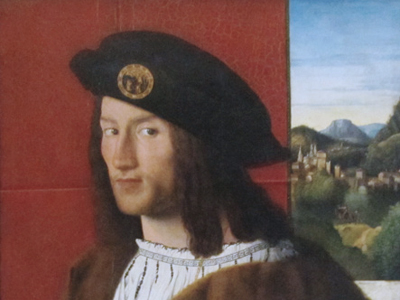 |
| Portrait of a gentleman - click to enlarge |
Agnolo Bronzino (Florence from 1503 to 1572).
He learned the art by Pontormo. In 1541 he entered the Florentine Academy, was in Rome in 1548, returned to Florence in time to be expelled from the Academy of Florence and at the height of artistic contention was appointed reformer of the Academy of Design and finally reinstated with full honors in the Academy of Florence.
His story shows how bitter was the conflict between conservatives and innovators.
Bronzino was a great portraitist, at the Barberini Gallery we see one of his masterpieces, the portrait of Stefano IV Colonna, general lieutenant of Cosimo de' Medici grand duke of Tuscany.
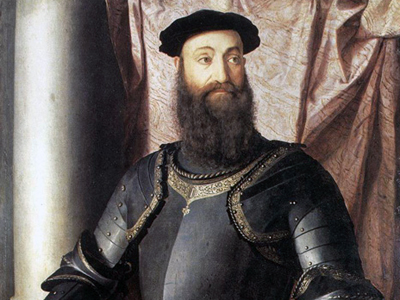 |
| Portrait of Stefano IV Colonna - click to enlarge |
Tintoretto (Venice 1518 - 1594), until 2007, his correct name was believed to be Jacopo Robusti, named Tintoretto because his father was “el Tentor” (=dyer), but as a matter of fact in 2007 the curator of the Spanish Prado Museum, Miguel Falomi, made incontrovertibly known that his real surname was Comin and that Robusti (=strong) was actually the nickname of his father.
Strong the father, stronger the son, so that because of his expressive power was also called the Furious.
He was one of the greatest Venetian painters and is considered the last great Renaissance painter, however, his "furious" (today we would say dramatic), use of color, light and perspective opens the way to Baroque art.
As said Tintoretto was called by some the Furious and certainly not only his painting was energetic, but so was his character. Especially when he wanted to win a commission in competition with others.
The portraits were for the painters a safer way for success, but they had to fight against the time, because, as we all know, the important people have little time to waste. Then Tintoretto worked out an original technique to be as swift as possible, preparing in advance proofs of portraits, so when the Doge Girolamo Priuli commissioned his own portrait, people said that he ended it in half an hour (hard to believe!).
The Gallery exhibits one of his most famous paintings, “Christ and Adultery”, which demonstrates the characteristics of Tintoretto in the panorama of the Italian Renaissance.
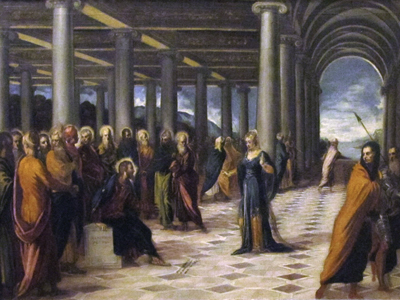 |
| Christ and Adultery - click to enlarge |
Dominikos Theotokopoulos alias El Greco (Crete 1541 - Toledo 1614), came into the world on the island of Crete. His artistic career began as a painter of icons in 1566 until he left for Venice, a must, as Crete belonged to Venice (only in 1669 Crete was occupied by the Ottomans).
In Venice he worked in the workshop of Titian, from here he went to Rome, where he was honored as to become a member of the Academy of San Luca.
The stay in Italy was instrumental in his artistic growth, as we can see that Tintoretto with his glow, his contrasts of light, found in the sensitivity of El Greco fruitful correspondence.
Around 1576 he went to Spain at the court of Philip II, his intent was to enhance the role of the king as defender of Christianity.
To understand this programmatic intent an historical digression is necessary.
The Ottomans had just been defeated (1571) in the Battle of Lepanto, stopping the irresistible advance that led them to destroy the kingdom of Serbia and Bulgaria, to conquer Buda and in 1453 Constantinople, where the famous church St. Sophia was converted into a mosque, and then again conquered Rhodes and Otranto. Finally someone like El Greco, born in Crete, felt the looming danger of the invasion of Ottomans, from which the Christian world had to defend and what better defender if not the great king of Spain?
The El Greco darkest fears had come true shortly after his death, in fact in 1648 the Turks landed in Crete.
Back to Philip II, El Greco did not breach his heart, then went away disappointed in Toledo where he remained until his death.
In the Palazzo Barberini Gallery we see “The Adoration of the Shepherds” and the “Baptism of Christ”, typical painting of El Greco maturity with the elongated figures lit by a silver light, where you can recognize the influence of Tintoretto.
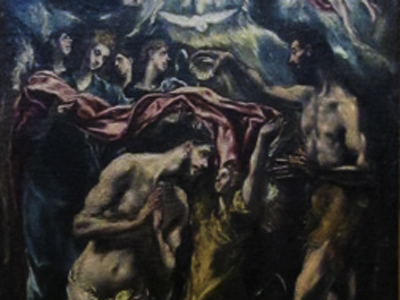 |
| Baptism of Christ - click to enlarge |
Annibale Carracci (Bologna 1560 - Rome 1609).
While the late Renaissance painting was running out Annibale Carracci committed himself with all his strength to recover and modernize the great Italian art of the early '500.
Arrived in Rome in the church of Santa Maria dei Funari painted the Santa Margherita, his first Roman public work. It is said that Caravaggio, after pausing at length to look at her exclaimed “I am pleased that in my time I see also one painter”.
In our gallery we see the intense Portrait of a young man.
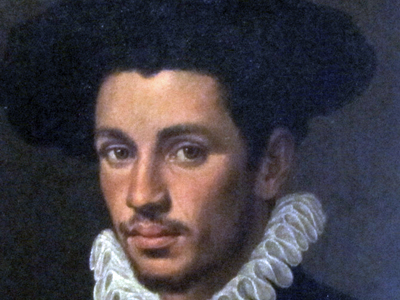 |
| Portrait of a young man - click to enlarge |
Guido Reni (Bologna 1575 - 1642), already nine years old devoted himself to painting. His father settled in the shop of his friend, the Flemish painter Calvaert, who committed himself to keep Guido for 10 years, here Guido was fortunate to have such classmates as Francesco Albani and Domenichino.
In 1600, left for Rome, where he returned several times thanks to the great success acquired.
Success due to his ability to merge classicism and naturalism looking for the ideal beauty.
Palazzo Barberini Gallery exhibits one of the best works of Guido, the portrait of “Beatrice Cenci”.
The tragic story of the Cenci has inspired writers such as Shelley, Stendhal and Dumas Father.
Beatrice Cenci in 1599 ended up beheaded, on the charge of having participated in the murder of his father, Count Francesco, along with her stepmother Lucrezia and her brother James. This father was tried twice for “wicked faults” and during the trial was accused of raping Beatrice. Nevertheless, defying the wrath of the Roman people, Lucrezia, Beatrice and James were sentenced to death by beheading the women, the man for quartering.
The execution took place in front of Castel Sant'Angelo, including riots in the crowd, followed by dead and drowned in the Tiber.
The meek Guido Reni, with Orazio Gentileschi and Caravaggio, was in place among common people.
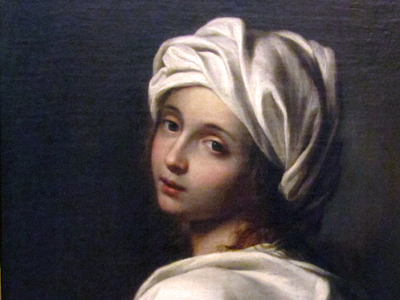 |
| Beatrice Cenci - click to enlarge |
Michelangelo Merisi, Caravaggio (Caravaggio or Milano 1571 or 73 - Porto Ercole 1610), the place of birth is discussed, according to some documents he was born in Caravaggio, according to other sources he was born in Milan.
However in order to escape the plague his parents left Milan to get Caravaggio, where his father and grandparents died of the plague. The widow returned to Milan with her four children; Caravaggio was employed (1584) for very little money in the shop of Simone Pederzano, a painter then in vogue.
From apprentice applied himself diligently for about four years, although, according to his biographers, even then he did “some extravagance”.
But over the years those eccentricities became more and more uncontrollable.
The violence, the drama, the provocative subversive of his paintings are a reflection of “a cursed life”.
In 1590 he was already in Rome.
Those early days were harsh, including poverty, disease and debauchery.
He entered the shop of Giuseppe Cesari, known as Cavalier D'Arpino, a successful painter.
Probably due to an illness, for which he was admitted to the Consolazione hospital (near the church of the same name), broke off his cooperation with Cavalier d'Arpino.
The turning point in the life of Caravaggio was in 1595 when he was discovered by Cardinal Del Monte, a great lover of art, which, in addition to salary and home, introduced him to the important people: the Marquis Giustiniani, the Barberini, the Maximo, the Colonna and finally Cardinal Scipione Borghese, to whom we owe many of the paintings today exposed in the Borghese Gallery.
And the success came.
But...
his “too much odd brain”, as said his patron Cardinal Del Monte, would have betrayed him several times.
Unable to keep away from prostitutes, drunkenness and taverns, spent his time in excesses, ranging from litigation to injury, arrested was released through the intervention of the French ambassador, shortly after another injury due to Lena (his model for the Pilgrims Madonna)
It is not enough, soon ran into new complaints of insults and stone-throwing against the bailiffs, interspersed with various other violence, until in 1606 clashed with Ranuccio, he was injured, the other died.
His protectors could not avoid his sentence to be behaved and the theme of the severed head, become an obsession for Caravaggio.
Meanwhile it was necessary to escape from Rome, therefore the Colonna family hid him in their feuds of Lazio.
But to ensure safety to the fugitive it was essential to get outside the borders of the Papal State, so the Colonna entrusted him to their relatives the Neapolitan Carafa-Colonna. Caravaggio remained in Naples a year of prolific painting and without extravagances.
After a year, in 1607, Caravaggio, thanks always to the Colonna, left Naples for Malta where was presented to the Grand Master of the Order of the Knights of St. John.
Why go to Malta?
The reason is simple: if he became a Knight would have granted immunity and therefore the sentence to beheading would be canceled.
In Malta, he painted the “Beheading of St. John the Baptist” which earned him the title of Knight of Grace.
Objective achieved, Caravaggio safe? Alas no, he betrays a new “extravagance”, clashes (injuries, wounds), with a noble knight, it turns out that he is a person sentenced to death and imprisoned. Escaped, do not know how, flees to Sicily, chased by thugs of the enemy Cavalier. While the outraged Knights of Malta expelled him “as a member stinking and putrid”.
In Sicily, hunted by the avengers of the offense Knight, he goes from city to city, always painting, before Syracuse, and Messina, finally Palermo, here embarked and returned to Naples, where was severely injured by the bullies of the relentless Maltese.
Circulated the news of his death, but Caravaggio recovered and trigger a new pictorial age in which certainly painted David with the Head of Goliath, one of his most dramatic works, in which the severed head of Goliath, his self-portrait, represents his obsessions and desire for death.
And death will come soon after.
His patrons had not given up hope of getting him the grace and Pope Paul V Borghese was ready to sign it. Caravaggio did not want to linger, take a ship to get close to Rome, amid various problems landed in Palo (about thirty miles from the coveted goal), the feud of the Orsini family, but his properties had remained on the ship and between them the picture of St. John the Baptist promised to Cardinal Scipione Borghese (nephew of the Pope). Caravaggio, then went back into the sea to reach the ship bound for Porto Ercole.
Worn and ill, came to Porto Ercole, where he died a few days before getting the papal pardon.
In his desperate life Caravaggio had no pupils, but his explosive personality gave birth to innumerable “caravaggeschi”, artists who painted inspired by the master.
In the Gallery of Palazzo Barberini you can see Judith and Holofernes, painted in 1599.
After a credible interpretation Judith represents Beatrice Cenci in the moment to kill the outrageous father, what explains the horror expressed by the face of Judith-Beatrice.
Anyway the most dramatic character is Holofernes, who very likely depicts Caravaggio himself. The Caravaggio’s metaphor means that he himself judges worthy his beheading because of his violent and dissolute life.
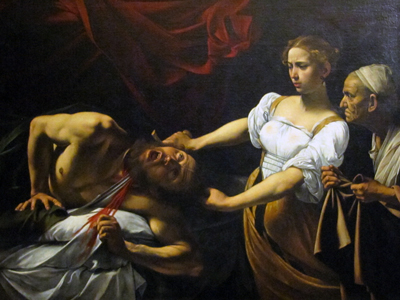 |
| Judith and Holofernes - click to enlarge |
back |

